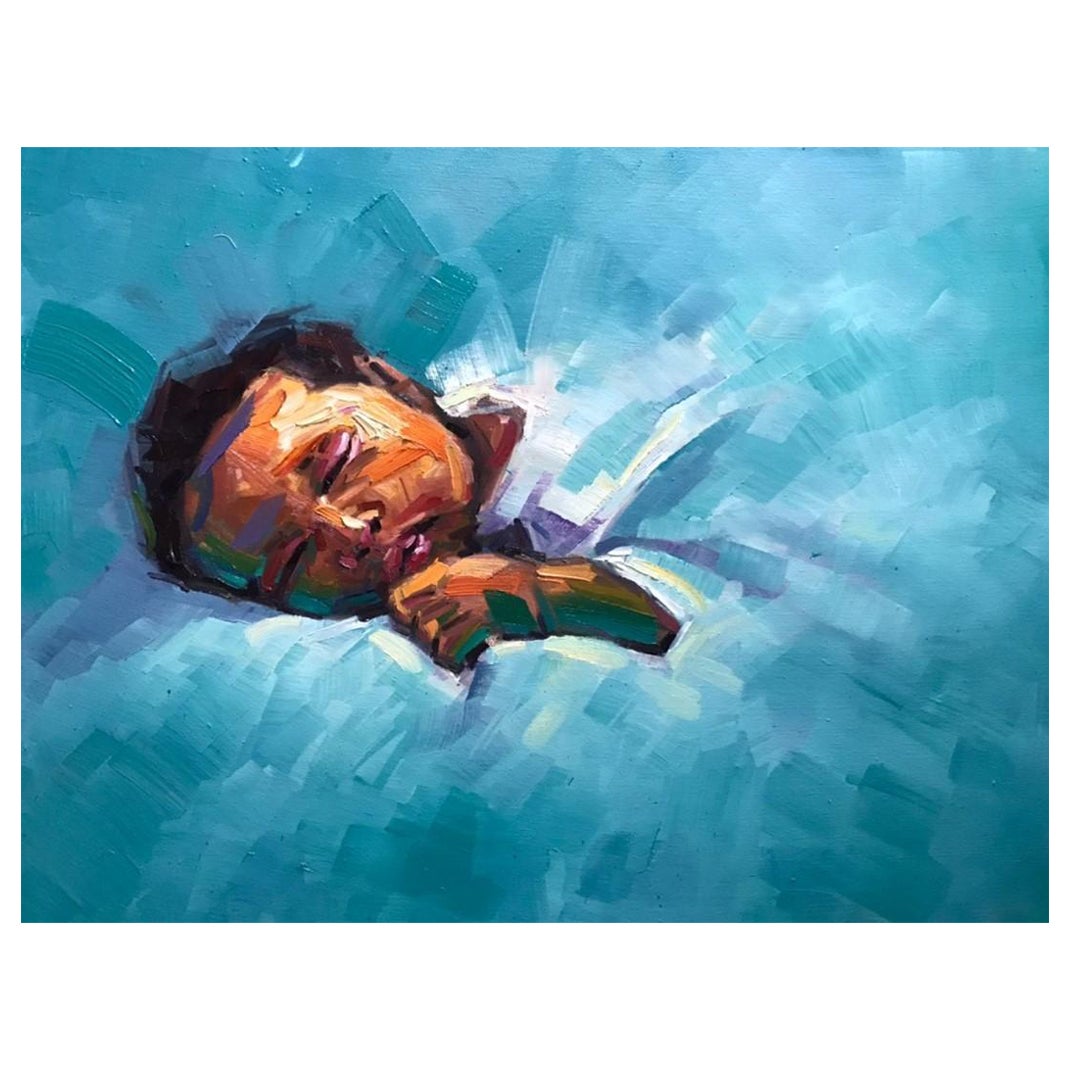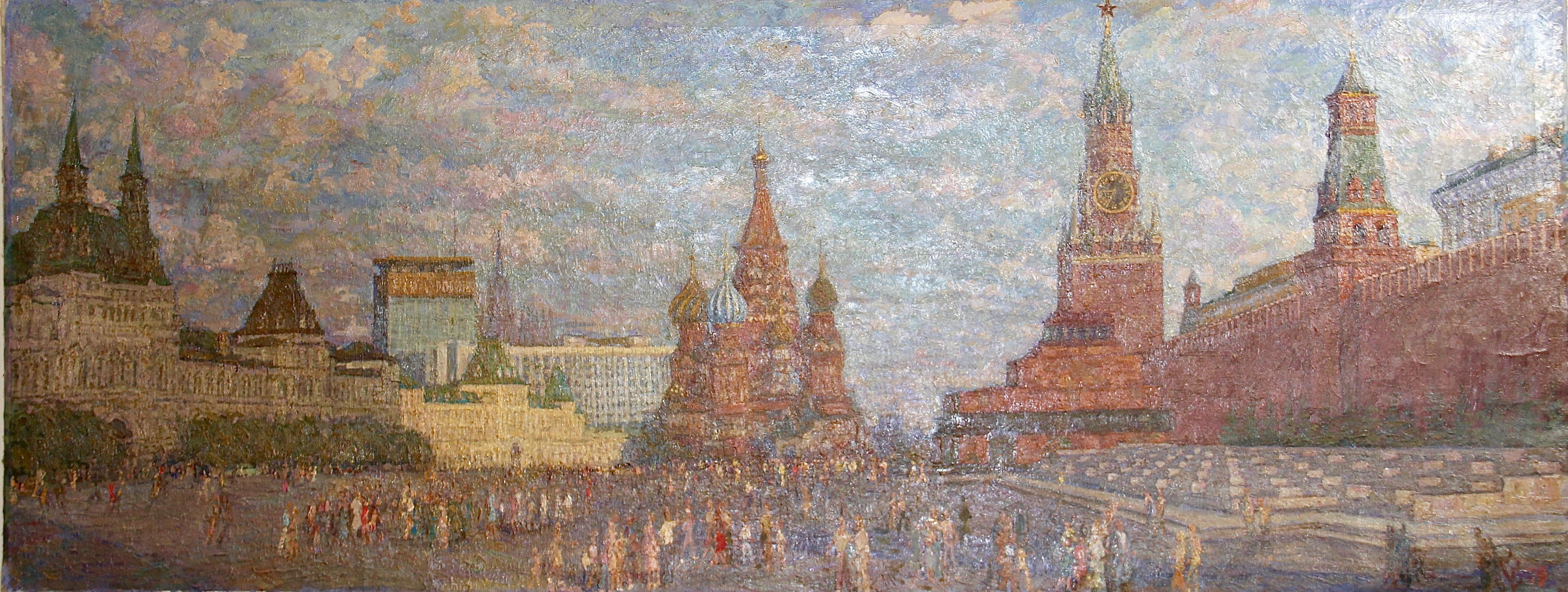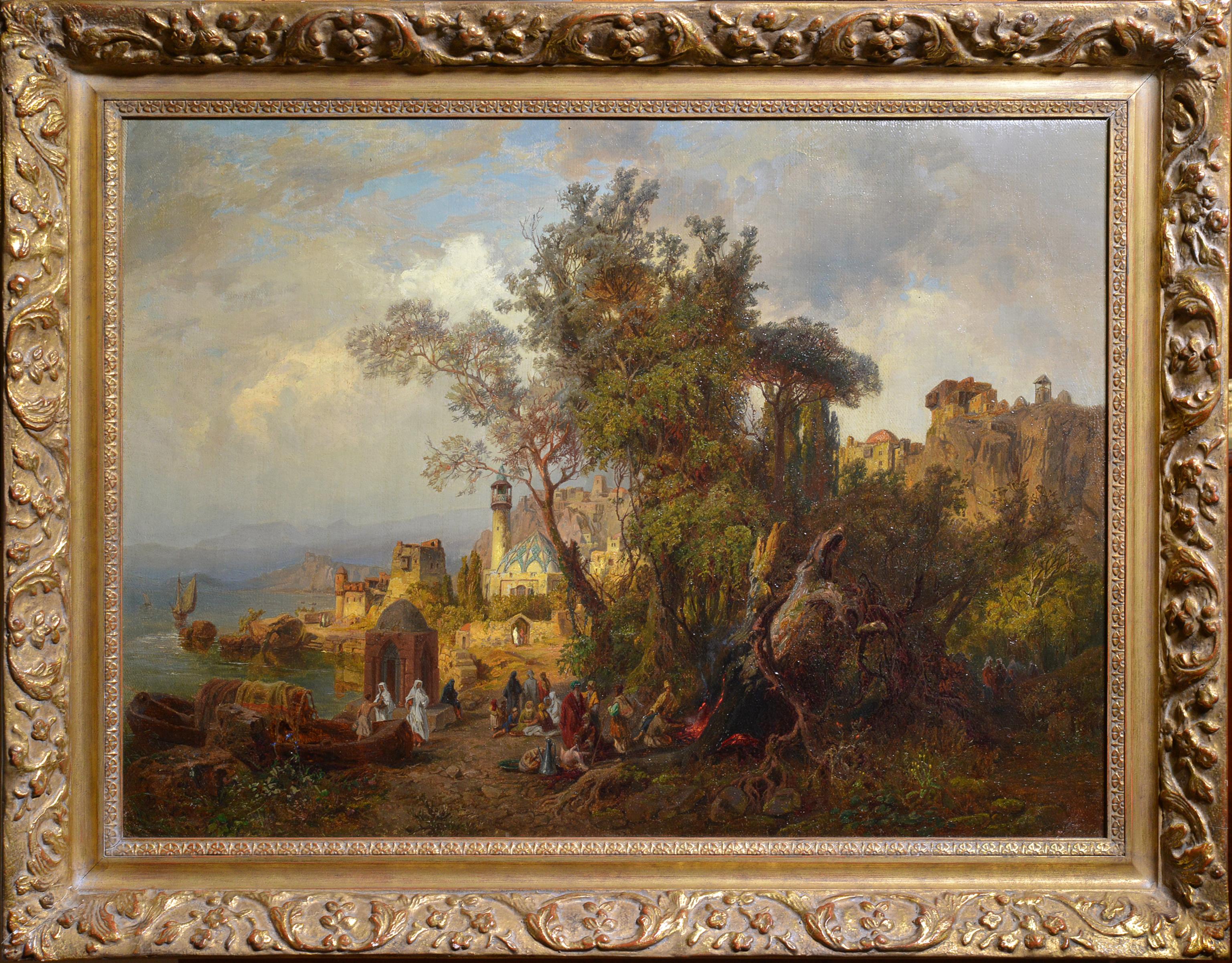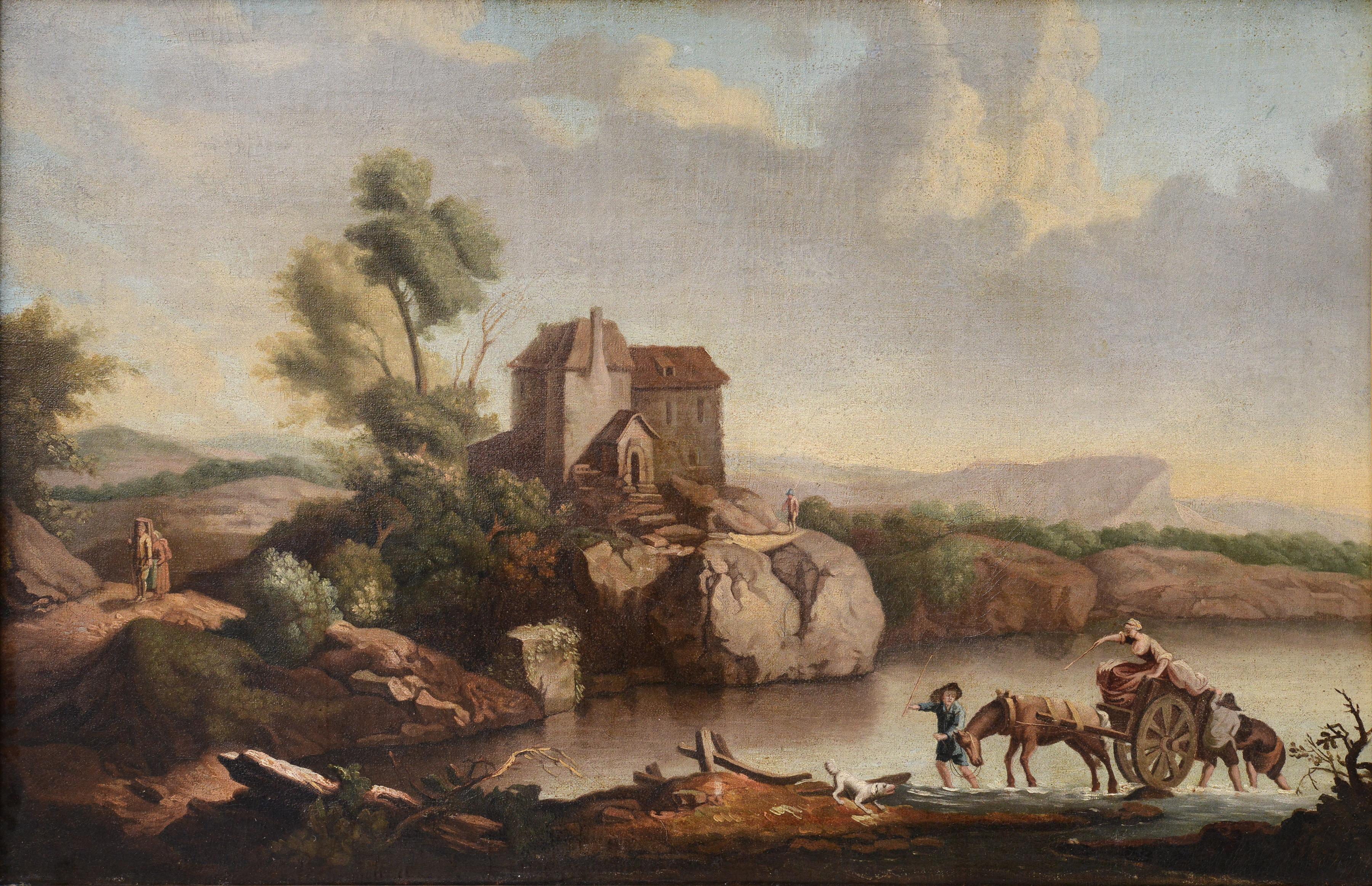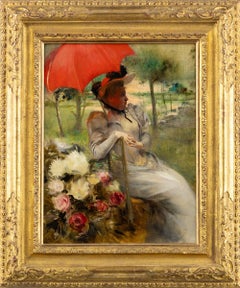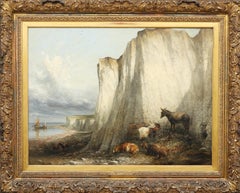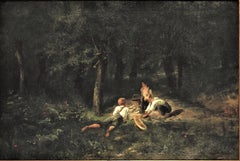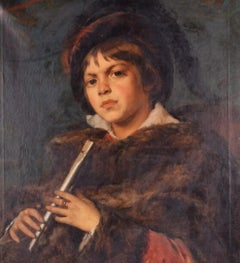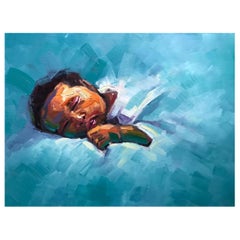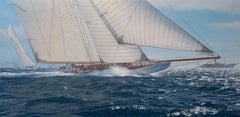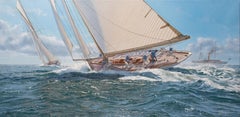Items Similar to Washerwomen by the river, oil on canvas by Karl Girardet
Want more images or videos?
Request additional images or videos from the seller
1 of 13
Karl GirardetWasherwomen by the river, oil on canvas by Karl Girardet
About the Item
This painting is part of a series of paintings Girardet made of washerwomen by the river. Upon their presentation they had a considerable success, which endures till now. In 2008 another painting of this series was sold at Christie's .
Karl Girardet was born in 1813 in Le Locle, which at the time was part of France but is now part of Switzerland. Girardet lived and worked most of his life in Paris. After beginning his career as a painter of landscapes, he became a well-known history painter. As a confidant of the French king Louis Philippe I, he was also an official court painter.
After 1822, he lived in Paris, where he trained as a painter with Louis Hersent and Léon Cogniet. In 1836, he presented his first works in the Salon of Paris and started working as a copyist for the French royal court.
An alpine landscape presented at the 1837 Salon obtained him a first distinction, and he successfully collaborated with Cogniet on two great battle scenes exhibited at Versailles.
In 1839, Girardet illustrated his first book, Roland furieux, followed by Jardin des plantes by Boitard in 1842. After a six-month stay in Egypt, 1844, he continued illustrating works and completed several royal commissions for paintings of state occasions.
Drafted into the National Guard, Girardet witnessed the fall of the monarchy in July 1848 and fled to Brienz, Switzerland, where he painted landscapes. In 1850, he returned to France
In 1857, he moved his studio to the Montmartre quarter, where he would live until his death, and was admitted as a member of the Royal Academy of Amsterdam. In 1870, caught in a besieged Paris during the Prussian invasion of France, Girardet damaged his eyesight while sketching the Prussian positions. Seized by anguish, fearing blindness, he died, alone in his flat, of suffocation. He was unmarried, but had lived many years with the painter, Augustine Angelina Kaas, for whom he had provided a pension.
Girardet's art belongs to the tradition of Romanticism and to the popular movement in landscape painting called the "School of 1830". His landscapes, based on sketches often completed under adverse weather conditions and within one hour, exhibit a rare vivacity and mastery of subtle color, especially after his 1850 stay in Brienz. He was not enchanted by the snow-capped peaks of the Alps, preferring instead to portray lakes, streams and marshes, notably the rivers Aar, Eure and Marne.[2]
Girardet sought official recognition through his historical paintings. Later in his life, deprived of royal patronage by the political upheavals in France, his historical paintings met with little success, and he shifted his attention back to landscape painting, which he continued to exhibit in the Salon until the end of his life.
As a man of modest means, Girardet had little leisure to devote to his art and was compelled to earn money mainly as an illustrator. After 1855, he abandoned the Orientalist themes that had contributed to his success; and in his late period, as a diligent craftsman, he dedicated himself to the themes and formats in vogue with his bourgeois clients.
Girardet's success inspired many other French-speaking Swiss artists, and it helped Swiss art and Swiss landscapes gain recognition with a broad international public. Several of his works are exhibited in the Musée d'art et d'histoire of Neuchâtel and in the Musée national de Versailles.
- Creator:Karl Girardet (1813 - 1871, Swiss)
- Dimensions:Height: 15.75 in (40 cm)Width: 24.41 in (62 cm)
- Medium:
- Movement & Style:
- Period:
- Condition:
- Gallery Location:Gent, BE
- Reference Number:1stDibs: LU2140211283652
About the Seller
5.0
Vetted Professional Seller
Every seller passes strict standards for authenticity and reliability
Established in 2018
1stDibs seller since 2022
Typical response time: 5 hours
- ShippingRetrieving quote...Shipping from: Gent, Belgium
- Return Policy
Authenticity Guarantee
In the unlikely event there’s an issue with an item’s authenticity, contact us within 1 year for a full refund. DetailsMoney-Back Guarantee
If your item is not as described, is damaged in transit, or does not arrive, contact us within 7 days for a full refund. Details24-Hour Cancellation
You have a 24-hour grace period in which to reconsider your purchase, with no questions asked.Vetted Professional Sellers
Our world-class sellers must adhere to strict standards for service and quality, maintaining the integrity of our listings.Price-Match Guarantee
If you find that a seller listed the same item for a lower price elsewhere, we’ll match it.Trusted Global Delivery
Our best-in-class carrier network provides specialized shipping options worldwide, including custom delivery.More From This Seller
View AllThe Red Parasol, Oil on canvas by Edgard de St-Pierre De Montzaigle
Located in Gent, VOV
With The Red Parasol, Edgard de St-Pierre De Montzaigle delivers a painting that speaks to the viewer both visually and emotionally. The young woman, lost in thought, is sheltered by...
Category
Late 19th Century Landscape Paintings
Materials
Oil
Oil on canvas : Cattle near the cliffs of Herne Bay KENT by Thomas Syndey Cooper
By Thomas Sidney Cooper
Located in Gent, VOV
Thomas Sidney Cooper was one of the foremost animal painters of the Victorian period. He was born in Canterbury, Kent, and as a small child he began to show strong artistic inclinations, but the circumstances of his family did not allow him to receive any systematic training. By the time he was twelve years old, he was working in the shop of a coach painter. Later he obtained a job as a scene painter, and he alternated between these two occupations for about eight years. He still felt a strong desire to become an artist, and all his spare moments were spent drawing and painting from nature. At the age of twenty, he went to London, drew for a while in the British Museum, and was admitted as a student of the Royal Academy. Subsequently, he returned to Canterbury, where he was able to earn a living as a drawing master and by the sale of sketches and drawings.
In 1827, he settled in Brussels and married before taking up a position as a teacher in Brussels in 1829. There he befriended Eugène Joseph Verboeckhoven, the great Belgian animal painter, who greatly influenced his style. He was also influenced by the 17th Century Dutch School. Because of the Belgian Revolution, he returned to London where he settled and first exhibited at Suffolk Street in 1833. He exhibited forty-eight pictures at the British Institution between 1833 and 1863. ‘Landscape and Cattle’, Royal Academy 1833, was shown until 1902 without a break - a record for a continuous exhibit at the Royal Academy. Sheep and cattle were his most frequent subjects, although he did paint a few figurative subjects. Cooper collaborated between 1847 and 1870 with Frederick Richard Lee...
Category
1880s Realist Landscape Paintings
Materials
Canvas, Oil
Thomas Sidney CooperOil on canvas : Cattle near the cliffs of Herne Bay KENT by Thomas Syndey Cooper
$22,313 Sale Price
20% Off
Children playing in a forest
Located in Gent, VOV
Amédée Elié Servin — (1829-1884) : Children playing in a forest
A nice and confidently painted scene of three children playing in the midst of a dark forest. Through clever use of colour and light and dark effects, Elié Servin creates a mysterious and fairytale-like scene in which all attention is drawn to the playing children.
Amédée-Élie Servin (1829-1884)
Servin Amédée-Élie was a French painter and engraver, founder of the artistic community of Villiers-sur-Morin.
Servin was born to a tanner, who, disappointed by his son's failure in his studies, apprenticed him to an upholsterer where he learned to draw cartoons. He then entered the École des Beaux-Arts and studied under the painter Michel Martin Drolling. At this school, he befriended students of his generation, such as Jean-Jacques Henner, Benjamin Ulmann and Paul Baudry...
Category
1880s French School Figurative Paintings
Materials
Oil, Canvas
Boy with a flute
By Leon Herbo
Located in Gent, VOV
Léon HERBO (1850-1907), Young boy with a flute, oil on canvas, signed upper left and dated 1879. This painting seems inspired by the painting "Singing Boy with a Flute" by the Dutch ...
Category
Late 19th Century Dutch School Figurative Paintings
Materials
Canvas, Oil
Riders and Bedouins walking on a path near a cliff, Oil on panel by Honoré BOZE
Located in Gent, VOV
Cavaliers et bédouins marchants sur un chemin près d’une falaise.
(panneau 32 *20 cm)
Honoré Boze est un peintre orientaliste français, né à l'île Maurice...
Category
19th Century Figurative Paintings
Materials
Canvas, Oil
The blind man, oil on canvas by Maurice Langaskens
By Maurice Langaskens
Located in Gent, VOV
A masterfully painted scene originating from the artist's studio
In this painting, Langaskens brings together several motifs that were also the subject of his graphic work: the blind man, the priest, the nun and the farm that also appears in the famous etching "les toits rouges" (the red roofs). These elements are brought together in a dynamic and colourful composition, where the similarities to that other Belgian painter, Anto Carte, are striking.
Combining these elements in this way creates a certain tension. Is the work about mercy (helping a blind man), or are we spectators of a scene where a poor wretch's purse is stolen?
Striking is the use of impasto, in which the painter emphasises the texture of fabrics and skin via flowing lines.
Maurice Langaskens 1884 - 1946 Biography
A Belgian painter and printmaker, Maurice (Maurits) Langaskens enrolled in the Académie Royale des Beaux-Arts in Brussels in 1901, and was trained as a decorative painter by the leading Belgian muralist and sculptor Constant Montald. From early on, Langaskens was recognized as a fine draughtsman, and won several prizes at the Académie. After living and studying for a few months in France in 1906, mainly in Dijon, the young Langaskens settled in Schaerbeek, outside Brussels. He began his independent career in 1907, when he exhibited three decorative paintings at the Salon in Brussels for the first time and also had an exhibition of his work shown at the Salle Boute in the city. The following year he contributed six paintings to the 16th annual exhibition of the Belgian artist’s association ‘Pour l’Art’ in Brussels, where he was to exhibit frequently over the course of his later career, until 1941. (Langaskens also designed the poster for the 17th ‘Pour l’Art’ exhibition in 1909.) Also in 1908, one of his paintings was selected for an exhibition of modern Belgian art in Berlin. Much of Langaskens’s early work was in a vibrant and visually arresting Art Nouveau or Symbolist style. This bold and colourful manner also translated well into large-scale mural commissions, and he soon became one of the leading painter-decorators of the early 20th century in Belgium. His decoration of the town hall of the city of Zoutleeuw in 1912 earned the artist considerable fame and the praise of his teacher and mentor Montald: ‘He was one of the best students in the class; today he is the most outstanding artist among the decorators of our time.’ The same year the first of several exhibitions of Langasken’s work was mounted at the Cercle Artistique et Littéraire in Brussels. The outbreak of the First World War, however, brutally interrupted the rise of the artist’s successful career. Drafted into the Belgian army at the beginning of August 1914, Langaskens was captured by the Germans after less than a fortnight. He spent the next three and half years as a prisoner of war, at internment camps at Sennelager, Münsterlager and Göttingen. He produced numerous, mostly small-scale paintings and watercolours of portraits and depictions of many of his fellow prisoners, as well as scenes of daily camp life, that are today regarded as among his finest and most personal works. It was also during this period that he painted two of his best-known pictures, the large canvas In Memoriam, painted in 1916 and depicting the burial of a Belgian soldier by his comrades, and the monumental triptych Repose en Paix, painted between 1915 and 1918. After his liberation and return to Belgium, Langaskens exhibited over eighty of the paintings and drawings that he had produced as a prisoner of war at the Galerie Sneyers in Brussels in 1918. After the Armistice, Langaskens - suffering from aphasia and nervous disorders brought about by his long confinement - painted mainly easel pictures of winter landscapes, rustic genre scenes and floral subjects, and also produced a number of designs for tapestries, book illustrations and stained-glass windows. Within a few years, however, his health had recovered and he returned to undertaking large-scale decorative mural commissions. In 1920 Langaskens was one of the founders, alongside Montald, Jean Delville, Emile Fabry...
Category
20th Century Figurative Paintings
Materials
Canvas, Oil
You May Also Like
Nostalgia I
By Ajegbomogun Damilola
Located in Ibadan, Oyo
In "Nostalgia" a 21st -century Nigerian painter uses an impressionist technique the brushwork clearly visible —to evoke the haziness between wakefulne...
Category
2010s Romantic Landscape Paintings
Materials
Canvas, Oil, ABS
$800 Sale Price
20% Off
On the Red Square, Kremlin, Moscow - Realist, Landscape Painting, 20th Century
Located in Berlin, DE
Moscow. "On the red square". Kremlin, St. Basil's Cathedral. Russian art.
Very good condition. Unframed.
Solovykh Gennady Ivanovich (1932, Moscow).
Member of the Union of Artists ...
Category
1970s Realist Figurative Paintings
Materials
Canvas, Oil
Reliance, 1903 America's Cup
Located in Greenwich, CT
Signed lower left
The painting depicts Reliance in the first race of the 1903 Americas Cup. Sailed off Sandy Hook with a clear sky and a 12 knot breeze Reliance is shown with her ra...
Category
2010s Realist Landscape Paintings
Materials
Canvas, Oil
Shamrock III, 1903 America's Cup
Located in Greenwich, CT
Signed lower right
The painting depicts Shamrock iii during the second race of the 1903 Americas Cup. With Clouds of spray flying from her bow and streaming a foaming wake astern Capt Bob Wringe is shown straining at the helm of Shamrock. Wringe draws every inch of speed from his charge as he valiantly gives chase to Reliance during the first leg of the race. Shamrocks well trained crew lie flat along the windward rail while others stand by at their stations ready to trim sails as required. This race was remarkable for the performance of her crew as they battled desperately to stay in touch with Reliance around the 30 mile course. Sir Thomas Lipton watches...
Category
2010s Realist Landscape Paintings
Materials
Canvas, Oil
Evening on River German Master Caucasian Panoramic Landscape 19th century
Located in Stockholm, SE
Attributed Paul Von Franken (1818-1884), famous Gemany a genre and landscape painter, signed bottom right. Fertile scenery coastal town with castle, mosque, minaret, large travelers ...
Category
1850s Realist Landscape Paintings
Materials
Canvas, Wood, Oil
Crossing the ford Capriccio Baroque Landscape 18th century Oil Painting
Located in Stockholm, SE
As we gaze upon at this artwork, our eyes are immediately drawn to the foreground where a comical spectacle unfolds before us. A carriage, stubbornly stuck in the midst of a ford, se...
Category
Late 18th Century Realist Landscape Paintings
Materials
Canvas, Wood, Cotton Canvas, Oil
Recently Viewed
View AllMore Ways To Browse
Bubble Portrait
Indian Clubs
Georgian Portrait Oil Paintings
Running Figure
Signed Portrait Miniature
Four Horse Paintings
Pre Raphaelite Art
Cafe Display
Japanese Gouache
Vintage Baby Painting
Vintage Baby Paintings
Judge Portrait
Mary Frank Art
Medusa Art
Mexican Fish
Painting Vie
Raphael Oil Paintings
All Bird Pictures
